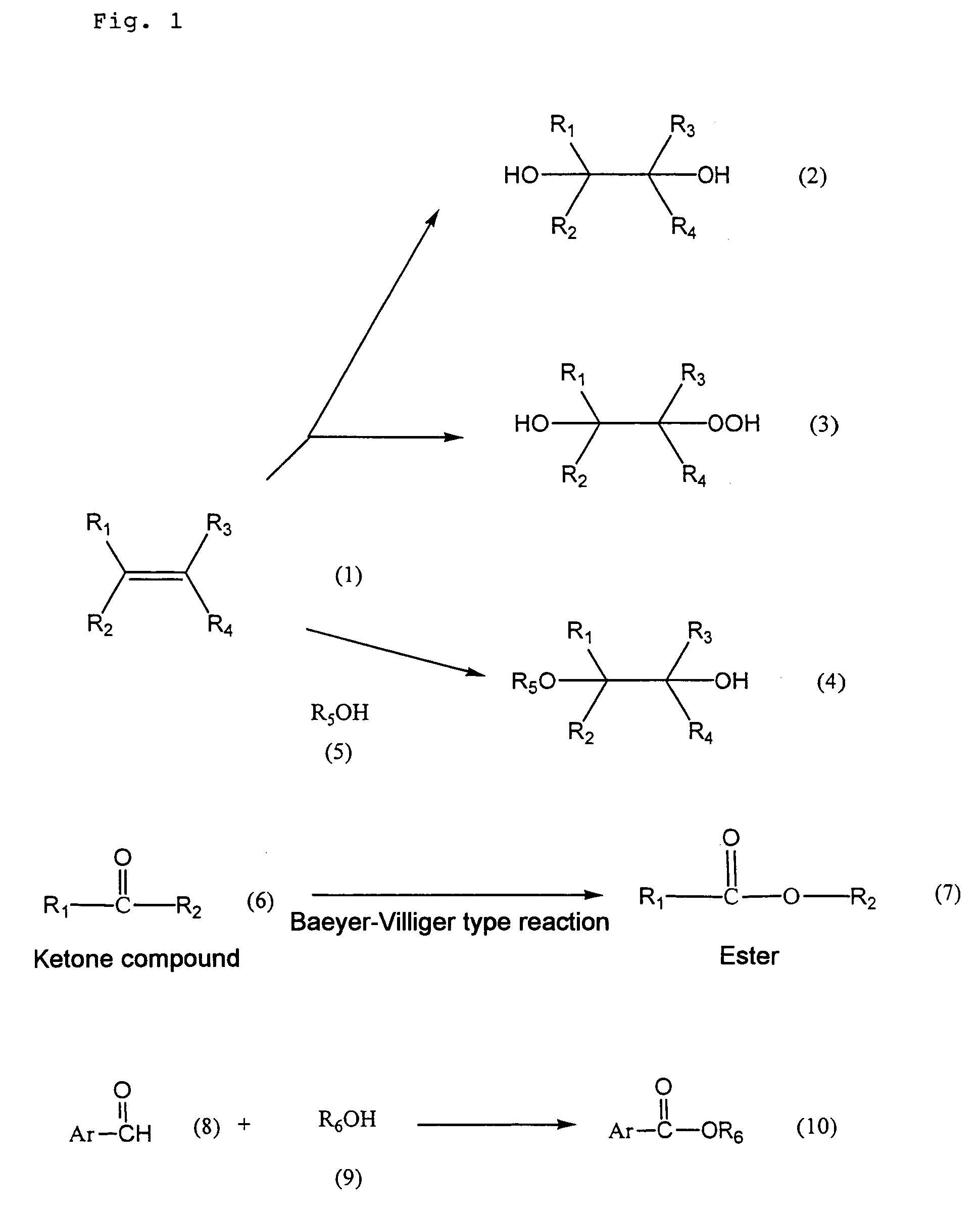Metallized mesoporous silicate and method of oxidation with the same
a mesoporous silicate and oxidation method technology, applied in the direction of metal/metal-oxide/metal-hydroxide catalysts, niobium compounds, lithium compounds, etc., can solve the problems of low activity of tungsten-containing mesoporous silicate alone, low 2-alkoxyalcohol, and two kinds of expensive compounds as catalysts
- Summary
- Abstract
- Description
- Claims
- Application Information
AI Technical Summary
Benefits of technology
Problems solved by technology
Method used
Image
Examples
example 1
[0122]To a 500 mL flask equipped with an induction stirrer were added 1 g of a tungsten metal powder and 5 g of ion-exchanged water, an inner temperature was raised to 40° C., 3 g of a 60% by weight aqueous hydrogen peroxide solution was added dropwise thereto over 30 minutes, and the mixture was maintained at the same temperature for 1 hour to obtain a tungsten oxide-containing solution. To the tungsten oxide-containing solution were added 100 g of ion-exchanged water and 80 g of ethanol, and then 10 g of dodecylamine was added dropwise thereto at an inner temperature of 40° C. over 30 minutes. Then, the mixture was cooled to an inner temperature of 25° C., and 41.6 g of tetraethoxysilane was added dropwise thereto over 30 minutes. When stirring was continued at an inner temperature of 25° C., crystals precipitated in about 30 minutes to form slurry, and this was further stirred and maintained at the same temperature for 24 hours. From the resulting slurry, crystals were collected ...
example 2
[0128]To a 500 mL flask equipped with an induction stirrer were added 5 g of a tungsten metal powder and 25 g of ion-exchanged water, an inner temperature was raised to 40° C., 15 g of a 60% by weight aqueous hydrogen peroxide solution was added dropwise thereto over 30 minutes, and the mixture was maintained at the same temperature for 1 hour to obtain a tungsten oxide-containing solution. To the tungsten oxide-containing solution were added 75 g of ion-exchanged water and 80 g of ethanol, and then 8 g of tetrabutylammonium hydroxide salt was added dropwise thereto at an inner temperature of 40° C. over 30 minutes. Then, the mixture was cooled to an inner temperature of 25° C., and 41.6 g of tetraethoxysilane was added dropwise thereto over 30 minutes. When stirring was continued at an inner temperature of 25° C., crystals were precipitated in about 30 minutes to form slurry, and this was stirred and maintained at the same temperature for 24 hours. From the resulting slurry, crysta...
example 3
[0134]To a 500 mL flask equipped with an induction stirrer were added 5 g of a tungsten metal powder and 25 g of ion-exchanged water, an inner temperature was raised to 40° C., 15 g of a 60% by weight aqueous hydrogen peroxide solution was added dropwise over 30 minutes thereto, and the mixture was maintained at the same temperature for 2 hours to obtain a tungsten oxide-containing solution. To the tungsten oxide-containing solution were added 75 g of ion-exchanged water and 80 g of ethanol, 41.6 g of tetraethoxysilane was charged therein at an inner temperature of 40° C. over 10 minutes, and 20 g of a 40% aqueous tetrabutylammonium hydroxide solution was added dropwise thereto over 10 minutes. Then, the mixture was cooled to an inner temperature of 25° C. and, when stirring was continued, crystals were precipitated in about 30 minutes to form slurry, and the mixture was stirred and maintained at the same temperature for 24 hours. From the resulting slurry, crystals were collected b...
PUM
| Property | Measurement | Unit |
|---|---|---|
| temperature | aaaaa | aaaaa |
| temperature | aaaaa | aaaaa |
| temperature | aaaaa | aaaaa |
Abstract
Description
Claims
Application Information
 Login to View More
Login to View More - R&D
- Intellectual Property
- Life Sciences
- Materials
- Tech Scout
- Unparalleled Data Quality
- Higher Quality Content
- 60% Fewer Hallucinations
Browse by: Latest US Patents, China's latest patents, Technical Efficacy Thesaurus, Application Domain, Technology Topic, Popular Technical Reports.
© 2025 PatSnap. All rights reserved.Legal|Privacy policy|Modern Slavery Act Transparency Statement|Sitemap|About US| Contact US: help@patsnap.com

